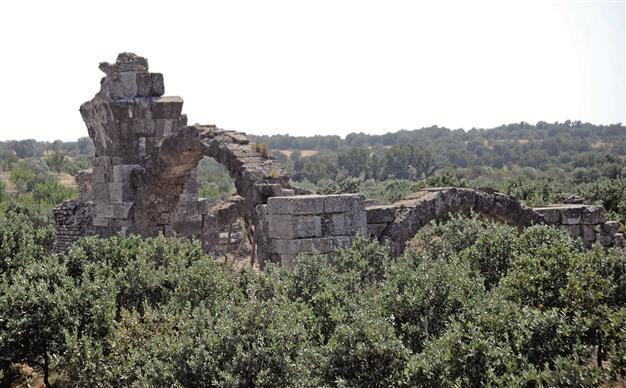Largest bath in Roman era a costly investment of time
ÇANAKKALE - Anadolu Agency

The Herodes Atticus Bath was the largest one in Anatolia in the Roman era. The structure largely collapsed in an earthquake in the winter of 1809-1810. AA photo
An ancient bath, which was constructed nearly 1,880 years ago in the eastern province of Çanakkale’s ancient city of Alexandria Troas in Ezine district’s Dalyan village, is one of the largest known structures and the largest bath in Anatolia from its era.
According to the head of the excavation team and Ankara University Archaeology Department member Associate Professor Erhan Öztepe, the Herodes Atticus Bath dates back to 135. Built by the Roman emperor Hadrian’s close friend Athenian Herodes Atticus, the bath is 100 meter long, said Öztepe and added, “The number of bathes in Anatolia in this size is too few. The Herodes Atticus Bath is the largest one in Anatolia in this era.”
Öztepe said that this significant structure in the ancient city largely collapsed in an earthquake in the winter of 1809-1810, and they were cleaning the area this year.
He said they were working to shed light on some facts in the plan of the structure, and would make it clear by emptying the bath through drilling. He said such a large bath showed the significance of the city at the time.
‘A high-cost investment’“Just like today, investments like this needed high costs in the ancient era, too. As far as we know from the sources, the structure cost some 3 million drachma [Greek currency at the time]. That was a lot of value in that era. The people of Alexandria Troas received great support from Emperor Hadrian in the establishment of some structures.
“According to an inscription in Athens, Hadrian was launched the ‘sponsor of the city’ in 132. An honorary inscription was made for him and placed in Athena Agora, because the emperor had special interest in this city. Three inscriptions that were unearthed in 2006 show Hadrian’s interest in the city
and the importance that city gave to him.”
The Herodes Atticus Bath, which has similar characteristics with theater bathes in the ancient city of Ephesus and the eastern bathes, is surrounded with walking corridors on three sides.
The bath and gymnasium (mental and physical education places in the ancient era) have marble walls and vaults. Water is delivered to the structure through aqueducts northeast of the bath. It is reported that the functions of spaces in the bath and gymnasium have not been clearly determined because there have been no excavations in the area so far.
The structure totals 123 x 84 meters and is the largest bath in Anatolia.
